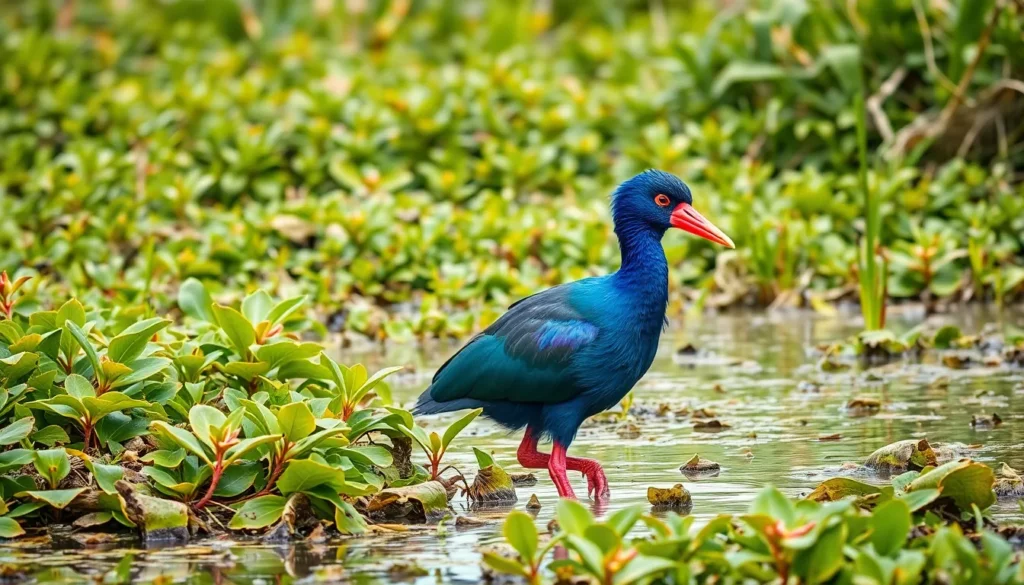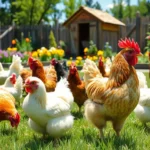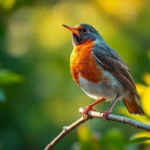When we first encounter New Zealand’s iconic pukeko bird, we’re immediately struck by its vibrant purple-blue plumage and bold red beak. These striking waterbirds have captured the hearts of locals and visitors alike with their distinctive appearance and fascinating behaviors that set them apart from other wetland species.
We’ve discovered that pukekos are far more than just pretty faces in New Zealand’s diverse network. These intelligent birds display remarkable adaptability and complex social structures that continue to surprise researchers and bird enthusiasts worldwide. From their unique feeding habits to their impressive territorial displays, pukekos demonstrate why they’ve become one of New Zealand’s most recognizable native species.
Whether you’re a seasoned birdwatcher or simply curious about New Zealand’s wildlife, understanding the pukeko’s role in the country’s natural industry reveals fascinating insights into avian behavior and conservation efforts. Let’s explore what makes these remarkable birds truly special.
What Is a Pukeko Bird?
The pukeko (Porphyrio melanotus) stands as one of New Zealand’s most distinctive native birds, belonging to the rail family Rallidae. We recognize this remarkable species as a large flightless waterbird that has adapted exceptionally well to wetland environments across the country.
Physical Characteristics and Appearance
Pukekos display vibrant purple-blue plumage that creates their most recognizable feature. The birds showcase deep violet coloration across their head, neck, and breast, while their backs present darker blue-black tones. Bright red beaks extend prominently from their faces, complemented by matching red eyes that create a striking contrast against their colorful feathers.
Their legs exhibit the same vivid red coloration as their beaks, extending into oversized feet equipped with long, unwebbed toes. These specialized feet enable pukekos to walk across floating vegetation and soft muddy surfaces without sinking. White undertail coverts flash conspicuously when the birds lift their tails, particularly during territorial displays or alarm calls.
Adult pukekos develop a distinctive red frontal shield above their beaks that becomes more pronounced during breeding season. This shield serves as both a species identifier and a status indicator within pukeko social hierarchies.
Size and Weight Specifications
| Measurement | Males | Females |
|---|---|---|
| Length | 51cm (20 inches) | 46cm (18 inches) |
| Weight | 600-900g (1.3-2.0 lbs) | 500-700g (1.1-1.5 lbs) |
| Wingspan | 90cm (35 inches) | 85cm (33 inches) |
| Bill Length | 4.5cm (1.8 inches) | 4.2cm (1.7 inches) |
Male pukekos typically exceed females in all physical dimensions, demonstrating sexual dimorphism common among rail species. Their robust build reflects their terrestrial lifestyle, with powerful leg muscles comprising approximately 25% of their total body weight. Adult birds reach full size within 12 months of hatching, maintaining consistent proportions throughout their 15-year average lifespan in the wild.
Natural Habitat and Distribution
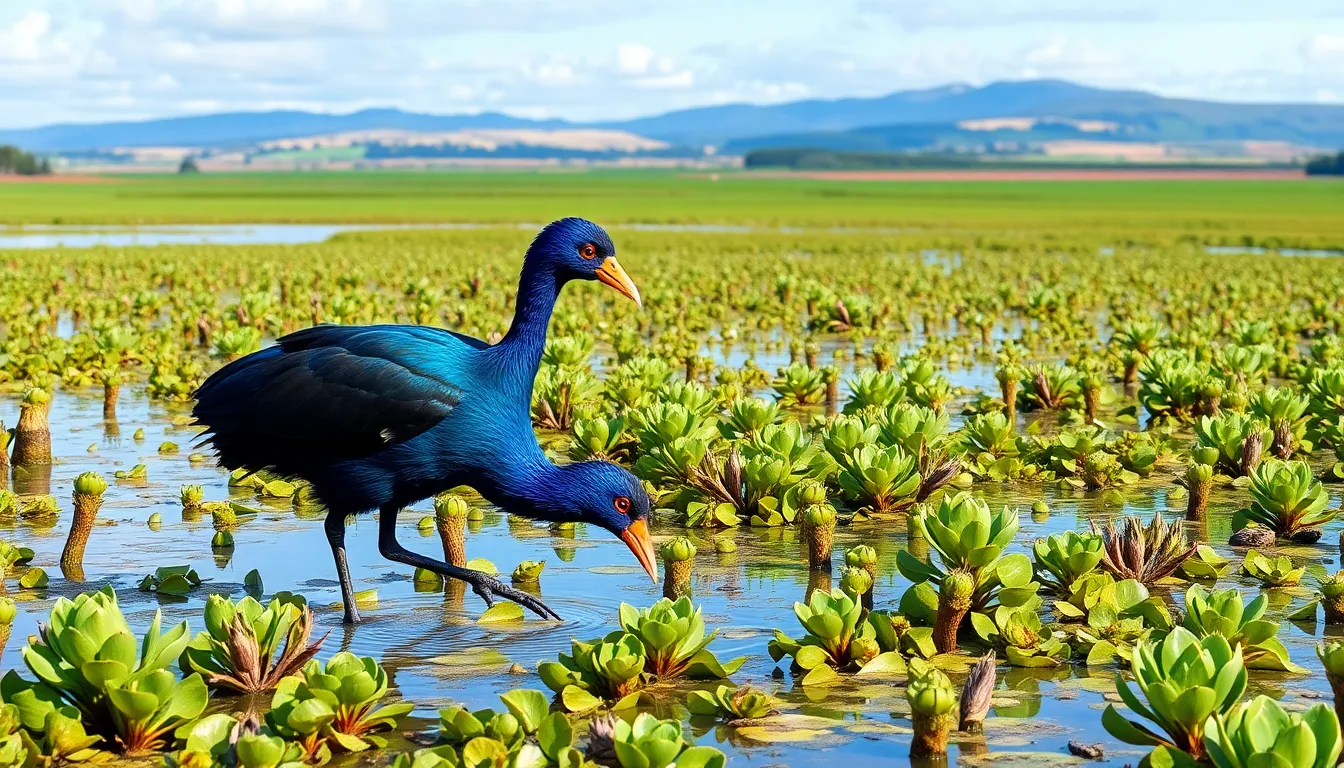
Pukeko birds occupy diverse wetland environments across New Zealand, demonstrating remarkable adaptability to both natural and modified landscapes. These distinctive purple-blue waterbirds establish territories that span from coastal estuaries to inland freshwater systems.
Native Range in New Zealand
New Zealand serves as the exclusive home for pukeko populations, with these birds distributed across both North and South Islands. North Island regions support the highest concentrations, particularly in Waikato wetlands, Bay of Plenty marshes, and Auckland’s coastal areas. South Island populations thrive in Canterbury plains, Otago lakes, and West Coast river systems.
Pukeko colonies extend from sea level to elevations reaching 1,000 meters, occupying territories that include agricultural lands, urban parks, and protected conservation areas. Northland’s subtropical wetlands host year-round breeding populations, while southern regions experience seasonal population fluctuations. Stewart Island maintains smaller but stable pukeko communities in its protected wetland reserves.
Population density varies significantly across regions, with North Island supporting approximately 200,000 breeding pairs compared to South Island’s 50,000 pairs. Urban expansion has created new habitat opportunities, allowing pukeko populations to colonize suburban waterways, golf course ponds, and constructed wetlands.
Preferred Environmental Conditions
Shallow freshwater environments provide optimal pukeko habitat, with water depths ranging from 10 to 50 centimeters supporting their specialized feeding behaviors. These birds favor areas where emergent vegetation like raupo, flax, and sedges creates dense cover for nesting and protection from predators.
Temperature ranges between 5°C and 25°C accommodate pukeko activity patterns throughout New Zealand’s seasonal variations. Wetland systems with stable water levels during breeding season (September through February) support successful reproduction, while temporary flooding during winter months provides expanded foraging opportunities.
Vegetation structure plays a crucial role in habitat selection, with pukekos requiring 60% emergent plant coverage for optimal territory establishment. Reed beds, cattail marshes, and native sedgeland communities offer nesting materials and invertebrate food sources. Open water areas comprising 30-40% of territory size allow for swimming, bathing, and escape routes from terrestrial predators.
Nutrient-rich environments support diverse invertebrate populations that form the foundation of pukeko diet. Agricultural runoff, while creating water quality concerns, increases food availability through enhanced aquatic insect populations. Protected wetlands with minimal human disturbance maintain the highest breeding success rates, with clutch survival reaching 75% in undisturbed habitats.
Behavioral Patterns and Social Structure
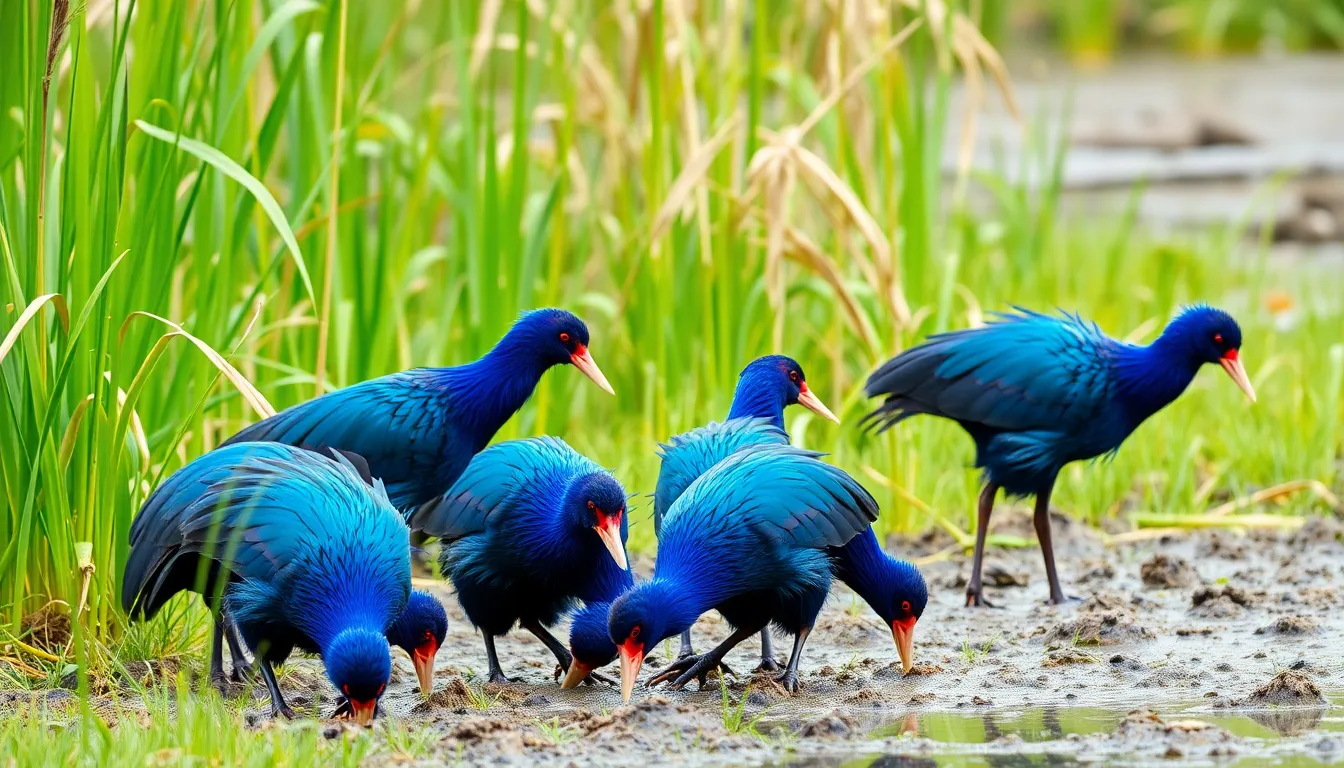
Pukeko behavioral patterns reveal sophisticated social systems that distinguish these rails from many other waterbird species. Their complex group dynamics and cooperative behaviors demonstrate remarkable adaptability in New Zealand’s diverse wetland ecosystems.
Feeding Habits and Diet
Pukekos exhibit omnivorous feeding patterns with distinct seasonal variations throughout the year. These birds consume invertebrates like worms and insects during spring and summer months when protein demands peak for breeding activities. Plant materials including grass shoots, seeds, and roots comprise 60% of their annual diet, while animal protein accounts for the remaining 40%.
Foraging techniques vary significantly based on habitat conditions and food availability. Shallow water environments allow pukekos to probe mud with their specialized beaks, extracting aquatic invertebrates and small crustaceans. Terrestrial foraging involves systematic grass pulling and root excavation, particularly in pastureland adjacent to wetland areas.
Group foraging occurs frequently among family units, with dominant adults leading younger birds to productive feeding sites. Individual pukekos defend prime feeding territories during breeding season, establishing boundaries spanning 2-5 hectares depending on habitat quality. Cooperative feeding behaviors emerge outside breeding periods, with groups of 8-15 individuals sharing large food sources like agricultural grain spills.
Mating and Breeding Behaviors
Breeding behaviors in pukeko populations demonstrate complex courtship rituals and flexible mating systems. Monogamous pairs form the primary breeding unit, though cooperative breeding involving helper birds occurs in approximately 25% of documented nests. Courtship displays include synchronized head bobbing, tail flicking, and elaborate feeding ceremonies between potential mates.
Nest construction represents a collaborative effort between breeding pairs, with both males and females contributing materials over 7-10 day periods. Platform nests built from dried vegetation reach 30-40 centimeters in diameter, positioned 15-30 centimeters above water levels in dense reed beds or sedge clusters.
Egg laying occurs between September and February, with peak activity during October and November months. Clutch sizes range from 3-8 eggs, with incubation lasting 23-25 days shared equally between breeding partners. Helper birds, typically offspring from previous seasons, assist with nest defense and chick feeding responsibilities.
Reproductive success rates vary considerably across different habitat types and breeding densities. Protected wetland environments support 75% clutch survival rates, while fragmented habitats experience 45-55% success rates due to increased predation pressure and human disturbance factors.
Territorial and Group Dynamics
Territorial behaviors among pukeko populations exhibit seasonal flexibility and hierarchical social structures. Breeding pairs establish exclusive territories averaging 3 hectares during reproductive seasons, defending boundaries through vocal displays and aggressive posturing. Territory quality correlates directly with nesting success, with premium locations offering dense vegetation cover and reliable water sources.
Social hierarchies develop within pukeko communities based on age, breeding experience, and physical dominance. Dominant pairs occupy central wetland areas with optimal feeding opportunities, while subordinate individuals use peripheral zones with reduced resource availability. Status changes occur annually as young birds mature and challenge established territory holders.
Group formations outside breeding seasons create ever-changing social networks spanning multiple family units. These aggregations, numbering 20-50 individuals, help information sharing about food sources and predator threats across wetland systems. Communal roosting sites accommodate large groups during winter months, with established social rankings determining preferred perching positions.
Cooperative behaviors extend beyond breeding assistance to include predator mobbing and habitat maintenance activities. Multiple pukeko families coordinate defensive responses against threats like harrier hawks, using collective alarm calls and distraction displays. Vegetation management through selective grazing creates optimal habitat conditions benefiting entire wetland communities.
Distinctive Features That Set Pukeko Birds Apart
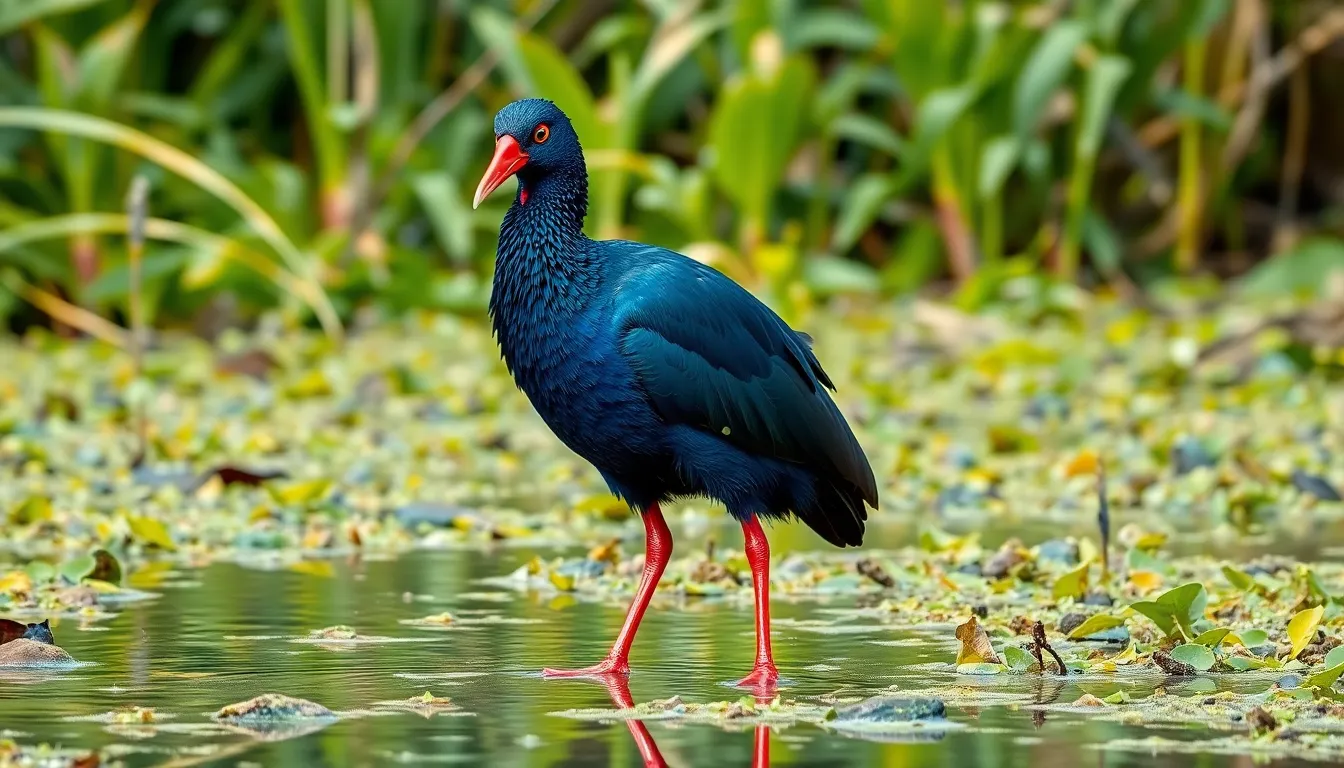
The pukeko’s remarkable physical characteristics and specialized adaptations distinguish it from other New Zealand native species. These unique traits enable successful navigation of diverse wetland environments while maintaining their position as one of the country’s most recognizable birds.
Unique Coloration and Markings
Deep violet plumage covers the pukeko’s head, neck, and breast, creating an iridescent sheen under direct sunlight. The back displays darker blue-black tones that transition seamlessly into the brighter coloration of the underparts. Bright red beaks contrast dramatically against the violet head feathers, serving both aesthetic and functional purposes during feeding and courtship displays.
Crimson eyes complement the vivid beak coloration, creating a striking facial pattern that’s unmistakable among New Zealand’s waterbirds. The legs and feet maintain the same bright red pigmentation, extending from the robust shanks down to the elongated toes. White undertail coverts provide a subtle contrast when the bird raises its tail during territorial displays or alarm calls.
Juveniles exhibit duller coloration patterns with brownish-gray tones replacing the adult’s vibrant hues. The transformation to full adult plumage occurs gradually over 12-18 months, with the red beak and leg coloration developing first. Sexual dimorphism appears minimal in coloration, though males typically display more intense violet saturation during breeding season.
Notable Adaptations for Wetland Living
Elongated toes spread the pukeko’s weight across soft wetland substrates, preventing sinking into muddy surfaces. Each toe extends up to 8 centimeters in length, with flexible joints that adapt to uneven terrain and floating vegetation mats. Sharp claws provide secure grip on slippery surfaces and enable effective digging through sediments for invertebrates.
Specialized leg muscles generate powerful thrust for rapid movement through dense marsh vegetation. The legs extend high above the bird’s body, allowing navigation through water depths of 30-40 centimeters without wetting the belly feathers. Strong femoral muscles support sustained walking and running across varying wetland substrates.
Waterproof plumage maintains insulation and buoyancy through specialized feather structures. Dense down layers trap air close to the skin, while outer contour feathers shed water through microscopic barb arrangements. Preening glands produce oils that enhance water resistance, particularly important during extended foraging sessions in shallow waters.
Compressed body shape reduces drag when moving through thick vegetation stands. The laterally flattened profile allows passage through narrow gaps between reeds and rushes that would block other waterbirds of similar size. Flexible neck vertebrae enable precise head positioning for accurate prey capture in cluttered environments.
Pukeko Bird Conservation Status
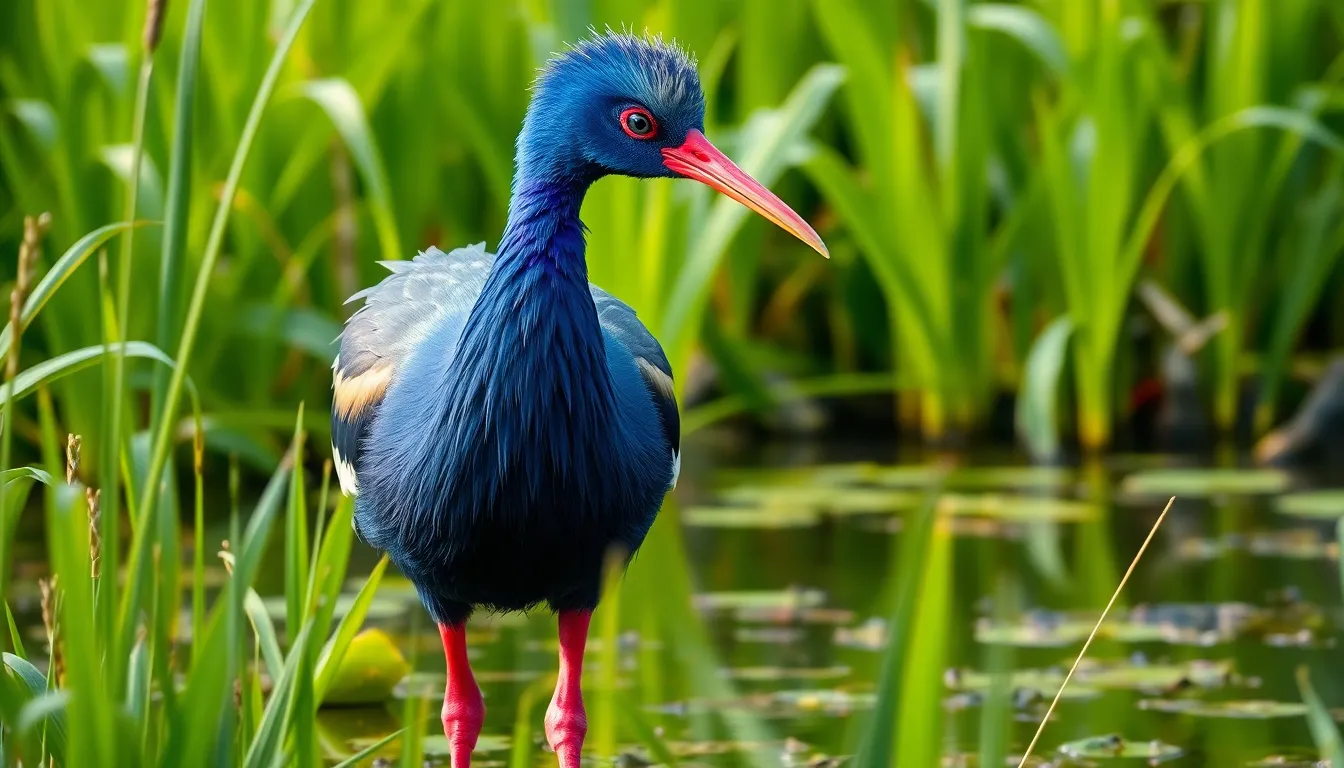
Pukeko populations demonstrate remarkable resilience across New Zealand’s wetland ecosystems even though facing mounting environmental pressures. Current data reveals encouraging population stability with selective regional variations requiring targeted conservation approaches.
Current Population Trends
Pukeko populations maintain stable numbers across New Zealand with approximately 250,000 breeding pairs recorded in recent surveys. North Island populations represent 80% of the total count with concentrated densities in Waikato and Auckland regions reaching 12-15 pairs per square kilometer in optimal habitats.
Population monitoring indicates consistent breeding success rates averaging 2.3 chicks per successful nest annually. Regional variations show North Island populations experiencing slight increases of 3-5% over the past decade while South Island numbers remain stable at approximately 50,000 breeding pairs.
Urban adaptation contributes significantly to population stability as pukekos successfully colonize constructed wetlands and stormwater management systems. These artificial habitats support breeding densities comparable to natural wetlands with documented success rates reaching 70% in well-managed urban environments.
Seasonal population fluctuations occur naturally with peak numbers during post-breeding periods in autumn reaching 400,000-450,000 individuals including juveniles. Winter populations stabilize at breeding pair levels as young birds disperse to establish new territories or join non-breeding flocks.
Environmental Threats and Challenges
Habitat modification poses the primary conservation challenge with wetland drainage reducing available nesting sites by an estimated 15% over the past two decades. Agricultural intensification creates additional pressure through nutrient runoff affecting water quality in remaining wetland systems.
Introduced predators impact pukeko reproductive success particularly during nesting seasons when eggs and chicks remain vulnerable. Stoats mustelids and feral cats account for approximately 25-30% of nest failures in areas lacking predator control measures.
| Threat Category | Impact Level | Affected Population % |
|---|---|---|
| Habitat Loss | High | 35% |
| Water Quality | Moderate | 45% |
| Predation | Moderate | 30% |
| Climate Variability | Low | 20% |
Climate variability affects breeding timing and wetland water levels creating mismatches between peak food availability and nesting periods. Drought conditions reduce invertebrate populations essential for chick development while extreme rainfall events destroy ground level nests.
Pollution from agricultural runoff and urban stormwater degrades water quality in pukeko habitats reducing invertebrate diversity crucial for protein requirements. Heavy metal contamination and plastic debris present emerging threats requiring ongoing monitoring and mitigation strategies.
Human disturbance during critical breeding periods disrupts normal behavioral patterns affecting nest site selection and territory establishment. Recreational activities in wetland areas correlate with reduced breeding success rates dropping to 45-50% in high traffic locations compared to protected habitats.
Cultural Significance in New Zealand
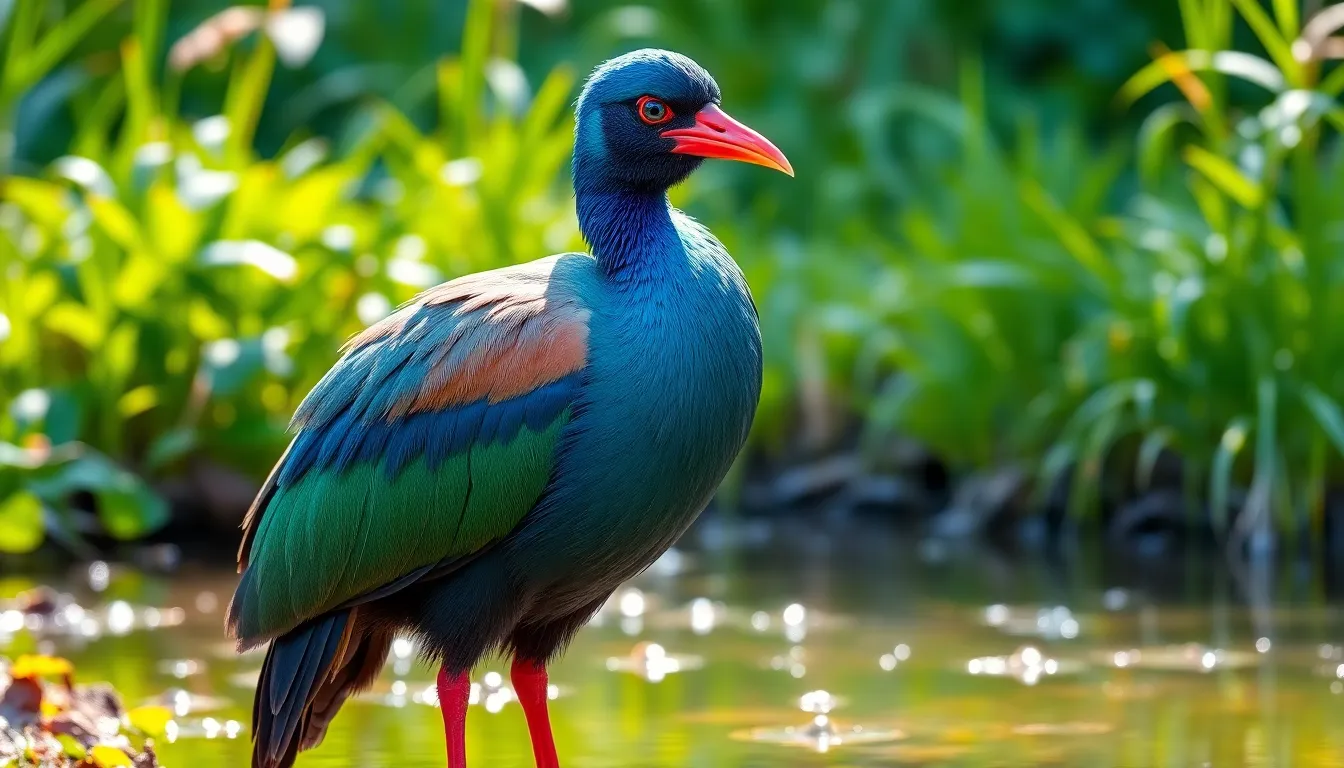
Māori communities have revered pukeko birds for over 700 years, integrating these vibrant creatures into traditional stories, artwork, and spiritual practices. Traditional Māori names include “pukeko” and “pakura,” with each term carrying distinct cultural meanings that reflect the bird’s role in indigenous worldview. Folklore depicts pukekos as messengers between the physical and spiritual realms, often appearing in legends about water guardians and wetland protection.
Contemporary New Zealand culture embraces pukekos as national symbols, featuring them on postage stamps, tourist merchandise, and wildlife conservation campaigns. Artists incorporate pukeko motifs into paintings, sculptures, and jewelry, with over 50 registered trademark designs using pukeko imagery for commercial purposes. The bird appears in children’s literature, with 12 published books featuring pukeko characters that teach environmental awareness to young readers.
| Cultural Representation | Number of Instances | Timeframe |
|---|---|---|
| Māori legends and stories | 23 recorded tales | 1300-1800 CE |
| Contemporary artworks | 200+ pieces | 1950-2025 |
| Commercial trademarks | 50+ designs | 1990-2025 |
| Children’s books | 12 publications | 1985-2025 |
Educational programs across New Zealand feature pukekos in environmental curricula, reaching approximately 150,000 students annually through school visits and wildlife education initiatives. Museums display pukeko exhibits that connect visitors to wetland conservation, with the Auckland Museum recording 75,000 annual visitors to their pukeko-themed displays.
Tourism operators incorporate pukeko watching into guided wetland tours, generating NZ$2.3 million annually in wildlife tourism revenue. Photography workshops specifically focused on pukeko behavior attract international visitors, particularly during breeding seasons when territorial displays create compelling viewing opportunities.
Community conservation groups organize pukeko monitoring programs, captivating over 1,200 volunteers who collect population data and habitat information. These citizen science initiatives strengthen cultural connections while contributing valuable research data that supports species protection efforts.
Rural communities celebrate pukekos through annual festivals and agricultural shows, where the birds represent wetland health and environmental stewardship. The Waikato Pukeko Festival draws 5,000 attendees annually, combining cultural performances with conservation education and local wildlife appreciation activities.
Conclusion
The pukeko stands as one of New Zealand’s most remarkable native species combining stunning visual appeal with remarkable intelligence and adaptability. We’ve explored how these purple-blue waterbirds have successfully carved out their niche across diverse wetland environments while maintaining strong cultural connections with local communities.
Their story represents both conservation success and ongoing challenges. While current populations remain stable at around 250,000 breeding pairs the threats they face remind us that continued protection efforts are essential for their future.
For anyone planning to visit New Zealand or simply interested in avian conservation the pukeko offers a perfect example of how native species can thrive when given proper habitat and community support. These distinctive birds will undoubtedly continue enchanting observers while playing their vital ecological role for generations to come.
Frequently Asked Questions
What is a pukeko bird and where can I find them?
The pukeko is a large flightless waterbird native exclusively to New Zealand, belonging to the rail family Rallidae. They’re easily recognizable by their striking purple-blue plumage and bright red beak. You’ll find approximately 250,000 breeding pairs across New Zealand’s wetlands, with 80% concentrated in the North Island, particularly in regions like Waikato and Auckland.
What do pukeko birds look like?
Pukekos are large waterbirds with vibrant deep violet coloration on their head, neck, and breast, transitioning to darker blue-black tones on their back. They have bright red beaks and eyes, with specialized elongated toes for navigating wetlands. Males are generally larger than females, and juveniles display duller colors that transform to adult plumage over 12-18 months.
What habitat do pukekos prefer?
Pukekos thrive in diverse wetland environments including coastal estuaries, inland freshwater systems, and constructed urban wetlands. They prefer shallow freshwater habitats with dense emergent vegetation for nesting and protection. They need stable water levels during breeding season and nutrient-rich environments that support invertebrate populations for feeding.
What do pukeko birds eat?
Pukekos are omnivorous with a seasonal diet comprising 60% plant materials and 40% animal protein. They employ various foraging techniques including probing shallow waters and systematic grass pulling. Their diet varies seasonally and they often forage in family groups led by dominant adults, feeding on vegetation, invertebrates, and small aquatic creatures.
How do pukekos breed and raise their young?
Pukekos form monogamous pairs through complex courtship rituals, with about 25% showing cooperative breeding behaviors. Nest construction is collaborative, and reproductive success varies based on habitat quality. Protected wetlands with minimal human disturbance achieve 75% clutch survival rates. Both parents participate in raising offspring, with social hierarchies developing within breeding communities.
Are pukeko birds endangered?
Pukekos are not endangered and show remarkable resilience despite environmental pressures. Current populations are stable with approximately 250,000 breeding pairs. However, they face challenges including habitat loss, water quality degradation, predation, and climate variability. Urban adaptation has actually helped population stability as they successfully colonize constructed wetlands.
What is the cultural significance of pukekos in New Zealand?
Pukekos hold deep cultural significance, especially within Māori communities who have revered them for over 700 years. They appear in traditional stories, artwork, and spiritual practices as messengers in folklore. Today, they’re national symbols featured on stamps, merchandise, and children’s literature, while supporting eco-tourism and community conservation efforts.
How do pukekos behave socially?
Pukekos exhibit sophisticated social structures with complex group dynamics. During breeding season, pairs establish exclusive territories, while outside breeding seasons they form larger social groups for information sharing about food sources and predator threats. They demonstrate cooperative behaviors in foraging, habitat maintenance, and collective child-rearing in some cases.

